Femtosecond Laser Surface Cleaning for Diamond Segmented Drill Bit Manufacturing
Abstract
:1. Introduction
2. Materials and Methods
2.1. Materials and Welding Process
2.2. Preparation of Test Samples
3. Experimental Results and Discussion
3.1. Macrostructure
3.2. Microstructure Characterization
3.2.1. Surface Analysis
3.2.2. Micro-Computer Tomography
3.2.3. Break-Out Test
3.2.4. Optical Microscopy
4. Conclusions
- The surface analysis shows one parameter (FSL5), out of six, with significantly better results than the untreated sample;
- Through the micro-CT analysis, the shade of grey diagram shows that four (FSL1, FSL3, FSL4, and FSL5) of the six treating parameters have a significant effect compared to the untreated sample. The highest value was shown by sample FSL4;
- Break-out value (BOV) is the principal qualification value in mass production, and the result of this test should be weighted;
- The break-out values show that only one treating parameter (FSL6) had a significant effect compared to the untreated sample;
- Microscopy analysis shows a single parameter (FSL1) with significantly better results than the untreated sample.
Author Contributions
Funding
Data Availability Statement
Acknowledgments
Conflicts of Interest
References
- Yong, J.; Chen, F.; Yang, Q.; Hou, X. Femtosecond Laser Controlling Wettability of Solid Surfaces. Soft Matter 2015, 11, 8897–8906. [Google Scholar] [CrossRef] [PubMed] [Green Version]
- Bizi-Bandoki, P.; Benayoun, S.; Valette, S.; Beaugiraud, B.; Audouard, E. Modifications of roughness and wettability properties of metals induced by femtosecond laser treatment. Appl. Surf. Sci. 2011, 257, 5213–5218. [Google Scholar] [CrossRef]
- Moradi, S.; Kamal, S.; Englezos, P.; Hatzikiriakos, S.G. Femtosecond laser irradiation of metallic surfaces: Effects of laser parameters on superhydrophobicity. Nanotechnology 2013, 24, 415302. [Google Scholar] [CrossRef] [PubMed]
- Schnell, G.; Polley, C.; Bartling, S.; Seitz, H. Effect of chemical solvents on the wetting behavior over time of femtosecond laser structured Ti6Al4V surfaces. Nanomaterials 2020, 10, 1241. [Google Scholar] [CrossRef]
- Shen, D.; Ming, W.; Ren, X.; Xie, Z.; Liu, X. Progress in non-traditional processing for fabricating superhydrophobic surfaces. Micromachines 2021, 12, 1003. [Google Scholar] [CrossRef] [PubMed]
- Yan, D.; Yu, Z.; Zou, T.; Lin, Y.; Kong, W.; Yang, J. Long-time persisting superhydrophilicity on sapphire surface via femtosecond laser processing with the varnish of TiO2. Nanomaterials 2022, 12, 3403. [Google Scholar] [CrossRef]
- Wang, B.; An, W.; Wang, L.; Jiao, L.; Zhang, H.; Song, H.; Liu, S. Superhydrophobic and antibacterial hierarchical surface fabricated by femtosecond laser. Sustainability 2022, 14, 12412. [Google Scholar] [CrossRef]
- Bonse, J.; Kirner, S.V.; Griepentrog, M.; Spaltmann, D.; Krüger, J. Femtosecond laser texturing of surfaces for tribological applications. Materials 2018, 11, 801. [Google Scholar] [CrossRef] [Green Version]
- Zhang, Y.; Zou, G.; Liu, L.; Wu, A.; Sun, Z.; Zhou, Y.N. Vacuum Brazing of Alumina to Stainless Steel Using Femtosecond Laser Patterned Periodic Surface Structure. Mater. Sci. Eng. A 2016, 662, 178–184. [Google Scholar] [CrossRef]
- Ye, G.; Wang, W.; Fan, D.; He, P. Effects of femtosecond laser micromachining on the surface and substrate properties of poly-lactic acid (PLA). Appl. Surf. Sci. 2021, 538, 148117. [Google Scholar] [CrossRef]
- Cheng, J.; Perrie, W.; Edwardson, S.P.; Fearon, E.; Dearden, G.; Watkins, K.G. Effects of laser operating parameters on metals micromachining with ultrafast lasers. Appl. Surf. Sci. 2009, 256, 1514–1520. [Google Scholar] [CrossRef]
- Nolasco, L.K.; Almeida, G.F.B.; Voss, T.; Mendonça, C.R. Femtosecond laser micromachining of GaN using different wavelengths from near-infrared to ultraviolet. J. Alloys Compd. 2021, 877, 160259. [Google Scholar] [CrossRef]
- Guo, B.; Sun, J.; Hua, Y.; Zhan, N.; Jia, J.; Chu, K. Femtosecond Laser Micro/Nano-manufacturing: Theories, Measurements, Methods, and Applications. Nanomanufacturing Metrol. 2020, 3, 26–67. [Google Scholar] [CrossRef] [Green Version]
- Sikora, A.; Nourry, S.; Faucon, M.; Chassagne, B.; Kling, R.; Mincuzzi, G. Role of the intensity profile in femtosecond laser surface texturing: An experimental study. Appl. Surf. Sci. Adv. 2021, 6, 100136. [Google Scholar] [CrossRef]
- Giannuzzi, G.; Gaudiuso, C.; Di Mundo, R.; Mirenghi, L.; Fraggelakis, F.; Kling, R.; Lugar, P.M.; Ancona, A. Short and long term surface chemistry and wetting behaviour of stainless steel with 1D and 2D periodic structures induced by bursts of femtosecond laser pulses. Appl. Surf. Sci. 2009, 494, 1055–1065. [Google Scholar] [CrossRef]
- Maharjan, N.; Zhou, W.; Zhou, Y.; Guan, Y. Femtosecond laser cleaning for aerospace manufacturing and remanufacturing. In Proceedings of the Conference on Lasers and Electro-Optics Pacific Rim (CLEO-PR), Singapore, 31 July–4 August 2017. [Google Scholar] [CrossRef]
- Prokuratov, D.; Samokhvalov, A.; Pankin, D.; Vereshchagin, O.; Kurganov, N.; Povolotckaia, A.; Shimko, A.; Mikhailova, A.; Balmashnov, R.; Reveguk, A.; et al. Investigation towards laser cleaning of corrosion products from Lead Objects. Heritage 2023, 6, 1293–1307. [Google Scholar] [CrossRef]
- Harada, T.; Spence, S.; Margiolakis, A.; Deckoff-Jones, S.; Ploeger, R.; Shugar, A.N.; Hamm, J.F.; Dani, K.M.; Dani, A.R. Obtaining cross-sections of paint layers in cultural artifacts using femtosecond pulsed lasers. Materials 2017, 10, 107. [Google Scholar] [CrossRef] [Green Version]
- Xiaopeng, L.; Jing, F.; Jikang, F.; Yong, P.; Kehong, W. Parametric investigation of femtosecond laser welding on alumina using Taguchi technique. Optik 2021, 225, 165891. [Google Scholar] [CrossRef]
- Kim, S.; Kim, J.; Joung, Y.; Choi, J.; Koo, C. Bonding Strength of a Glass Microfluidic Device Fabricated by Femtosecond Laser Micromachining and Direct Welding. Micromachines 2018, 9, 639. [Google Scholar] [CrossRef] [Green Version]
- Maharjan, N.; Zhou, W.; Zhou, Y.; Guan, Y.; Wu, N. Comparative study of laser surface hardening of 50CrMo4 steel using continuous-wave laser and pulsed lasers with ms, ns, ps and fs pulse duration. Surf. Coat. Technol. 2019, 366, 311–320. [Google Scholar] [CrossRef]
- Wulz, T.; Canfield, B.K.; Davis, L.M.; Spanier, S.; Lukosi, E. Pulsed femtosecond-laser treatment and deep reactive ion etching of diamond. Diam. Relat. Mater. 2017, 74, 108–113. [Google Scholar] [CrossRef] [Green Version]
- Kenéz, A.Z.; Földes, T.; Lublóy, É. Effect of surface cleaning on seam quality of laser beam welded mixed joints. Case Stud. Constr. Mater. 2023, 18, e01904. [Google Scholar] [CrossRef]
- EN 10305-1; Steel Tubes for Precision Applications—Technical Delivery Conditions. Part 1: Seamless Cold Drawn Tubes. SIST: Ljubljana, Slovenia, 2002. Available online: https://standards.iteh.ai/catalog/standards/cen/3feb09b7-5fd0-498b-8c0c-42c96ee36d72/en-10305-1-2002 (accessed on 20 February 2023).
- Köse, C.; Topal, C. Effect of heat input and post-weld heat treatment on surface, texture, microstructure, and mechanical properties of dissimilar laser beam welded AISI 2507 super duplex to AISI 904L super austenitic stainless steels. J. Manuf. Process. 2022, 73, 861–894. [Google Scholar] [CrossRef]
- Berczeli, M.; Tajti, F. Optimization of material removal parameters by femtosecond laser pulses. IOP Conf. Ser. Mater. Eng. 2020, 903, 012026. [Google Scholar] [CrossRef]
- Tajti, F.; Berczeli, M. Development of high power femtosecond laser microstructures on automotive stainless steel. IOP Conf. Ser. Mater. Eng. 2020, 903, 012025. [Google Scholar] [CrossRef]
- ISO 4287:1997; Geometrical Product Specifications (GPS)—Surface Texture: Profile Method—Terms, Definitions, and Surface Texture Parameters. International Organization for Standardization: Geneva, Switzerland, 1997. Available online: https://www.iso.org/standard/10132.html (accessed on 20 February 2023).
- Stock, M.; Pasler, M.; Birkfellner, W.; Homolka, P.; Poetter, R.; Georg, D. Image quality and stability of image-guided radiotherapy (IGRT) devices. Radiother. Oncol. 2009, 93, 1–7. [Google Scholar] [CrossRef] [PubMed] [Green Version]
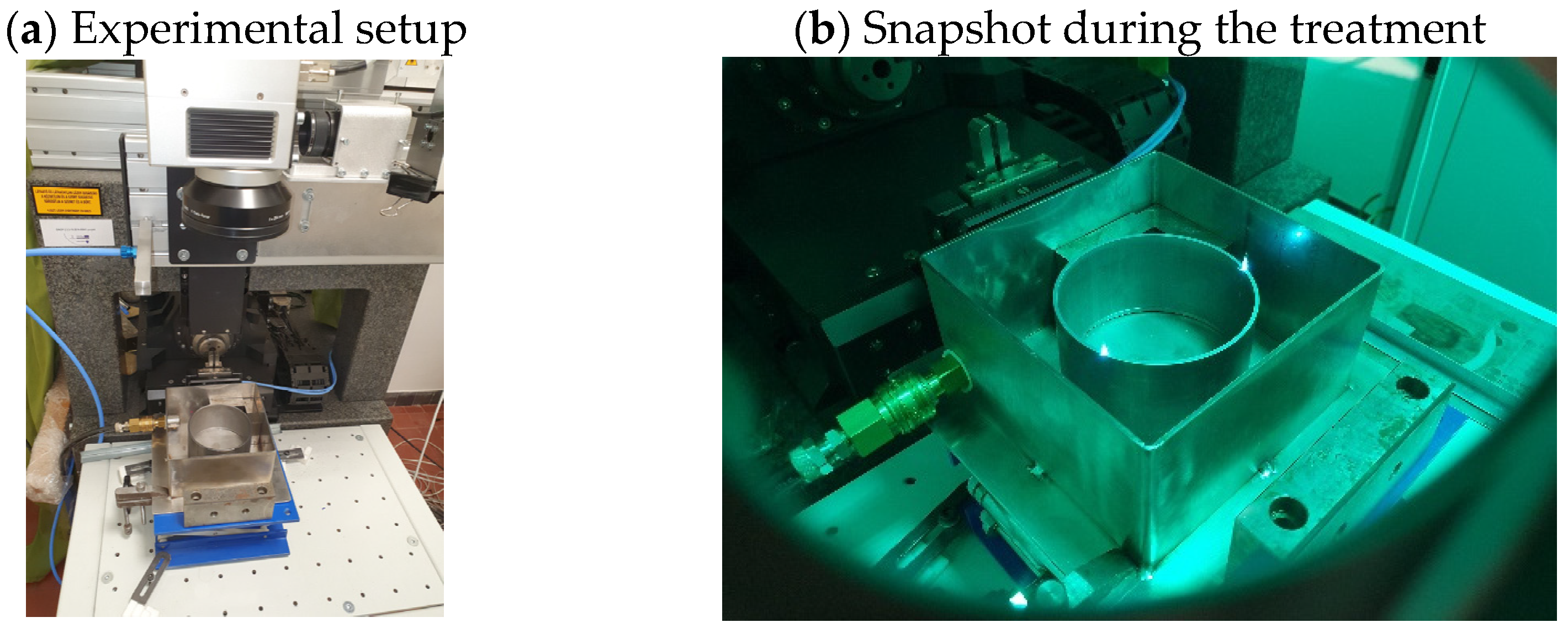
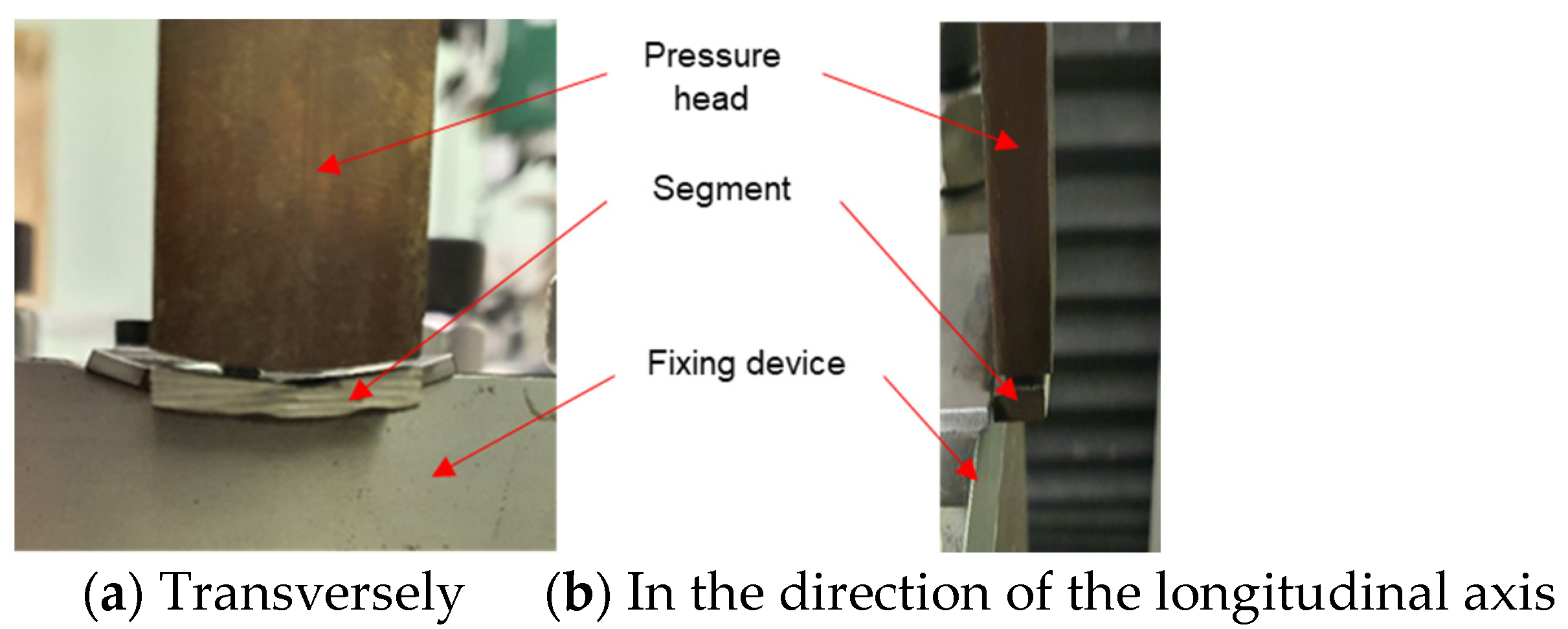
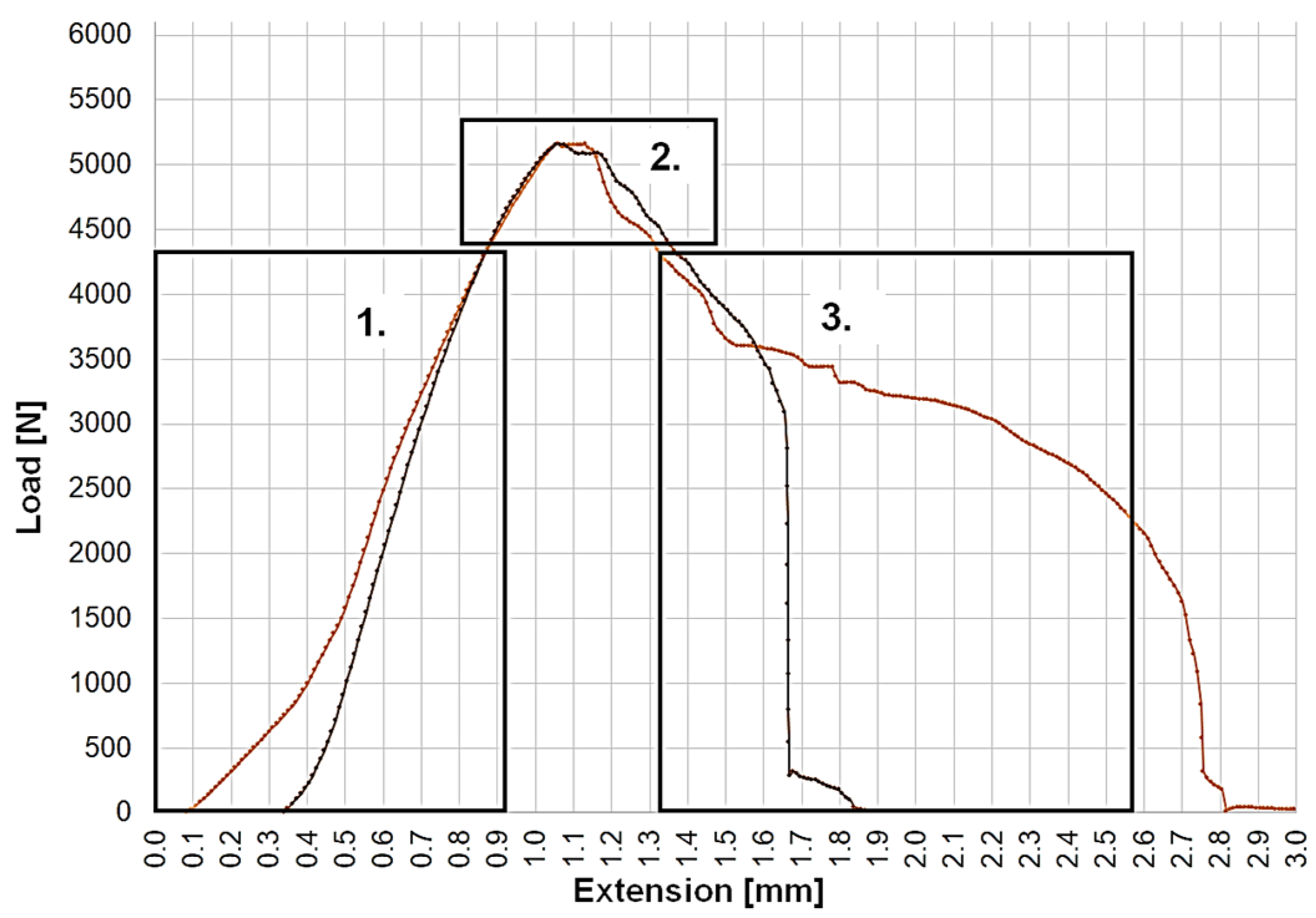

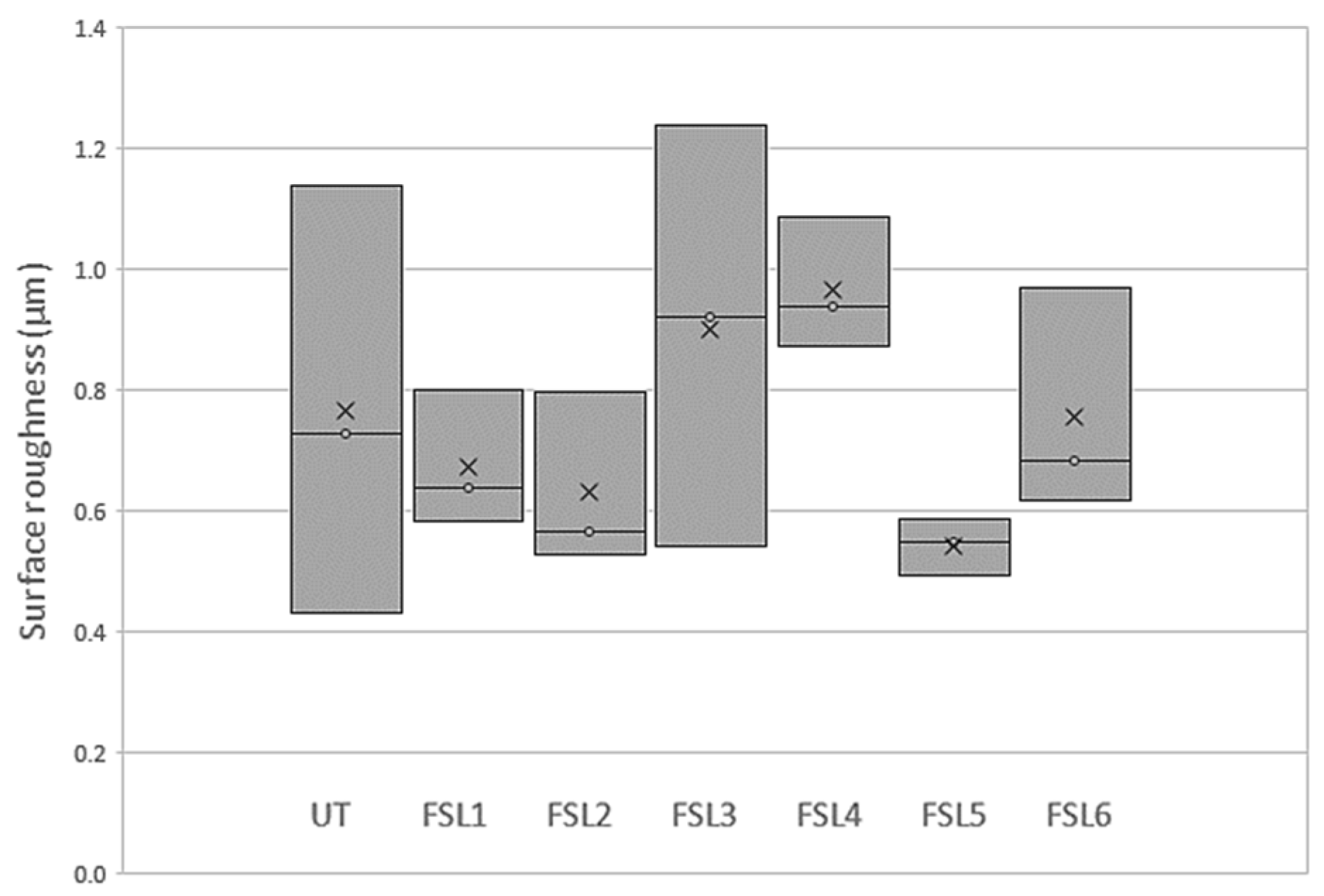
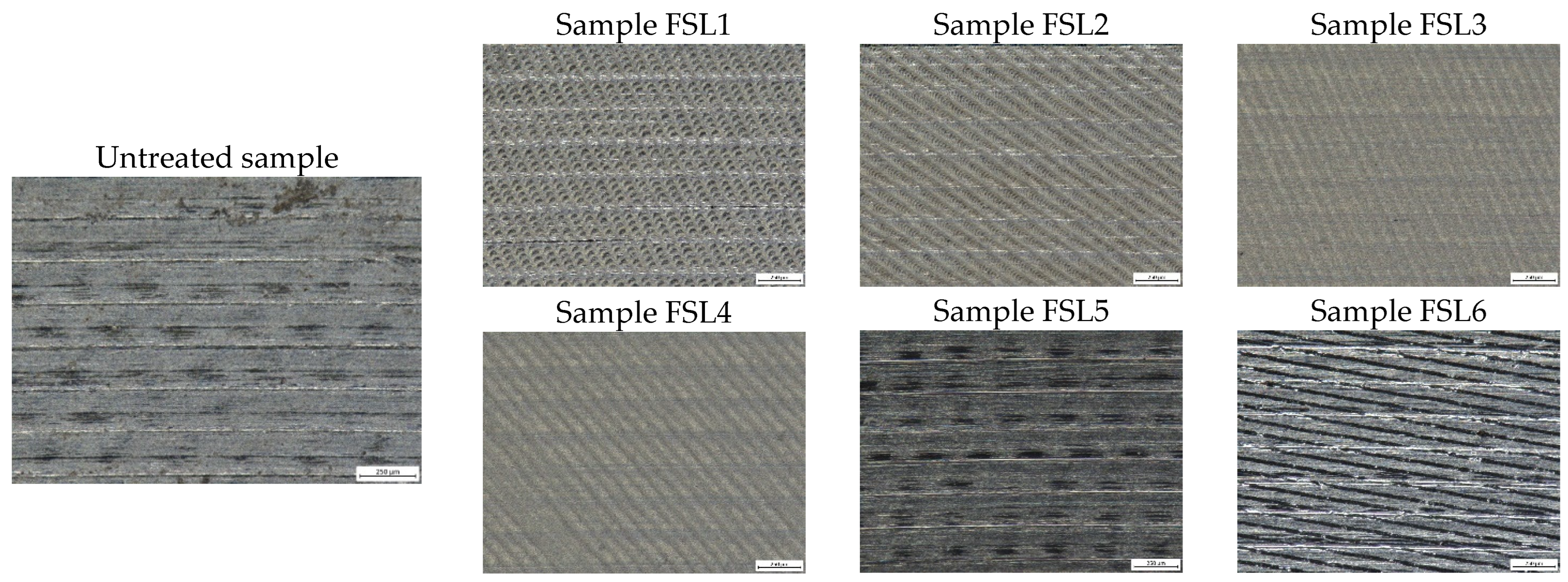
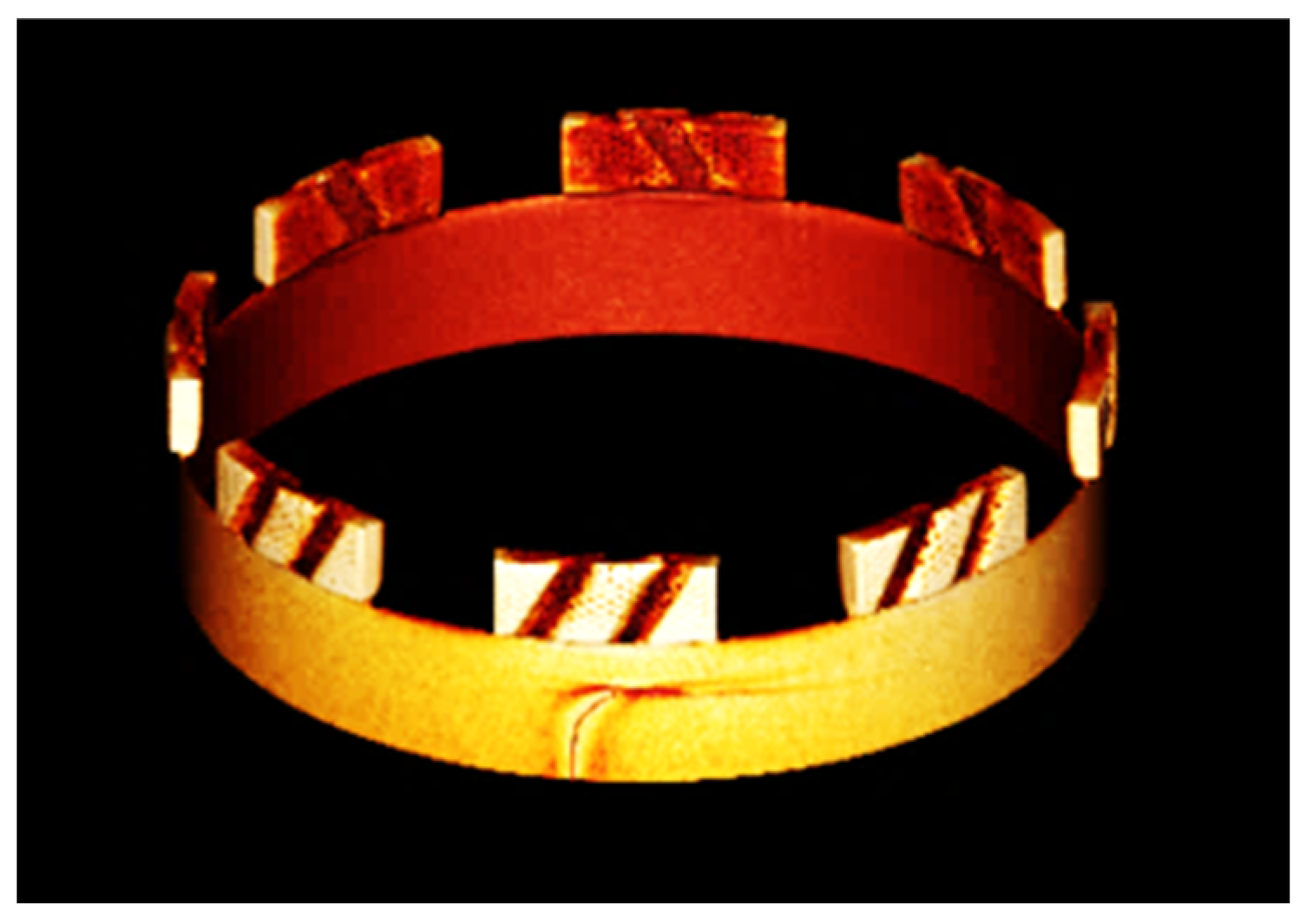
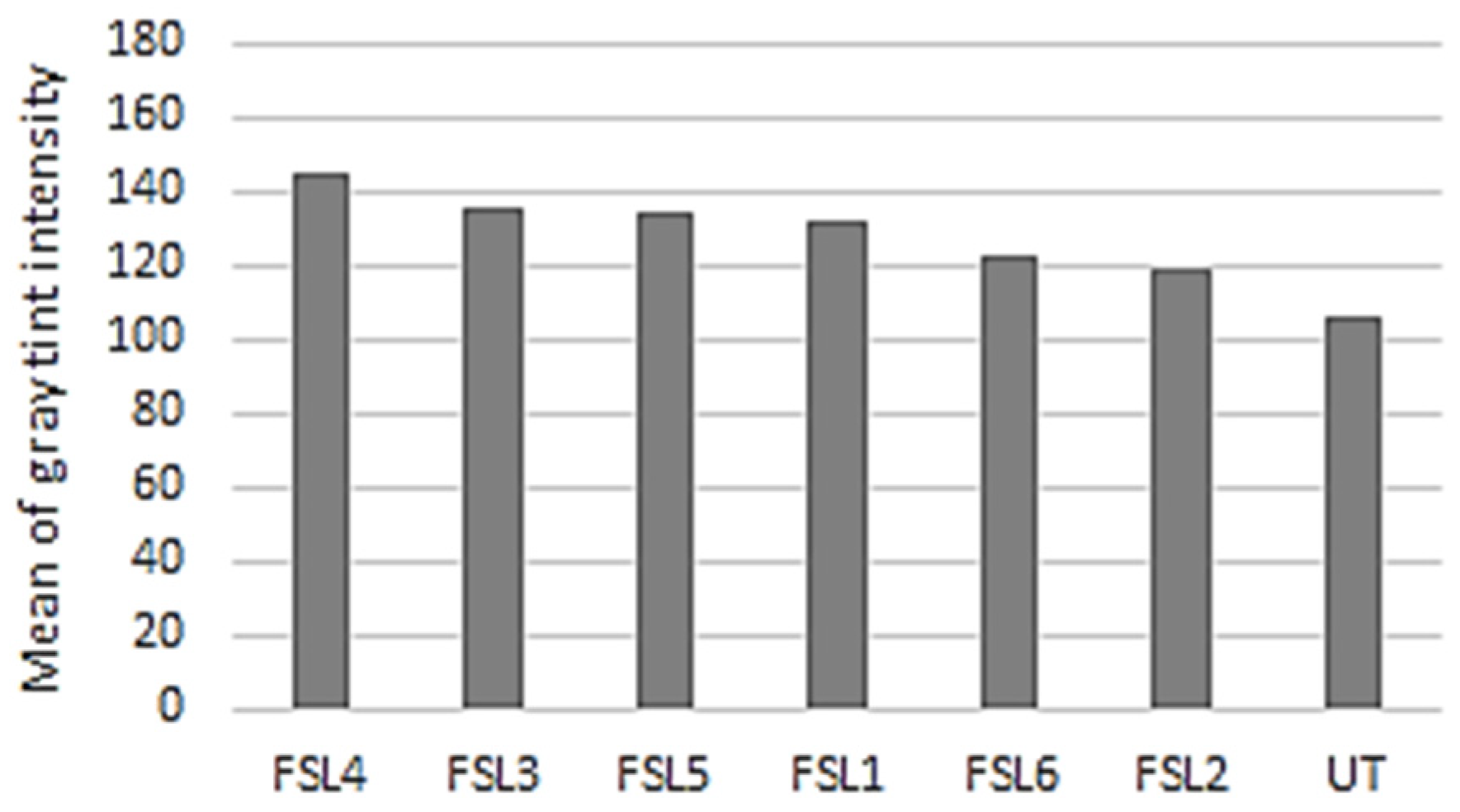

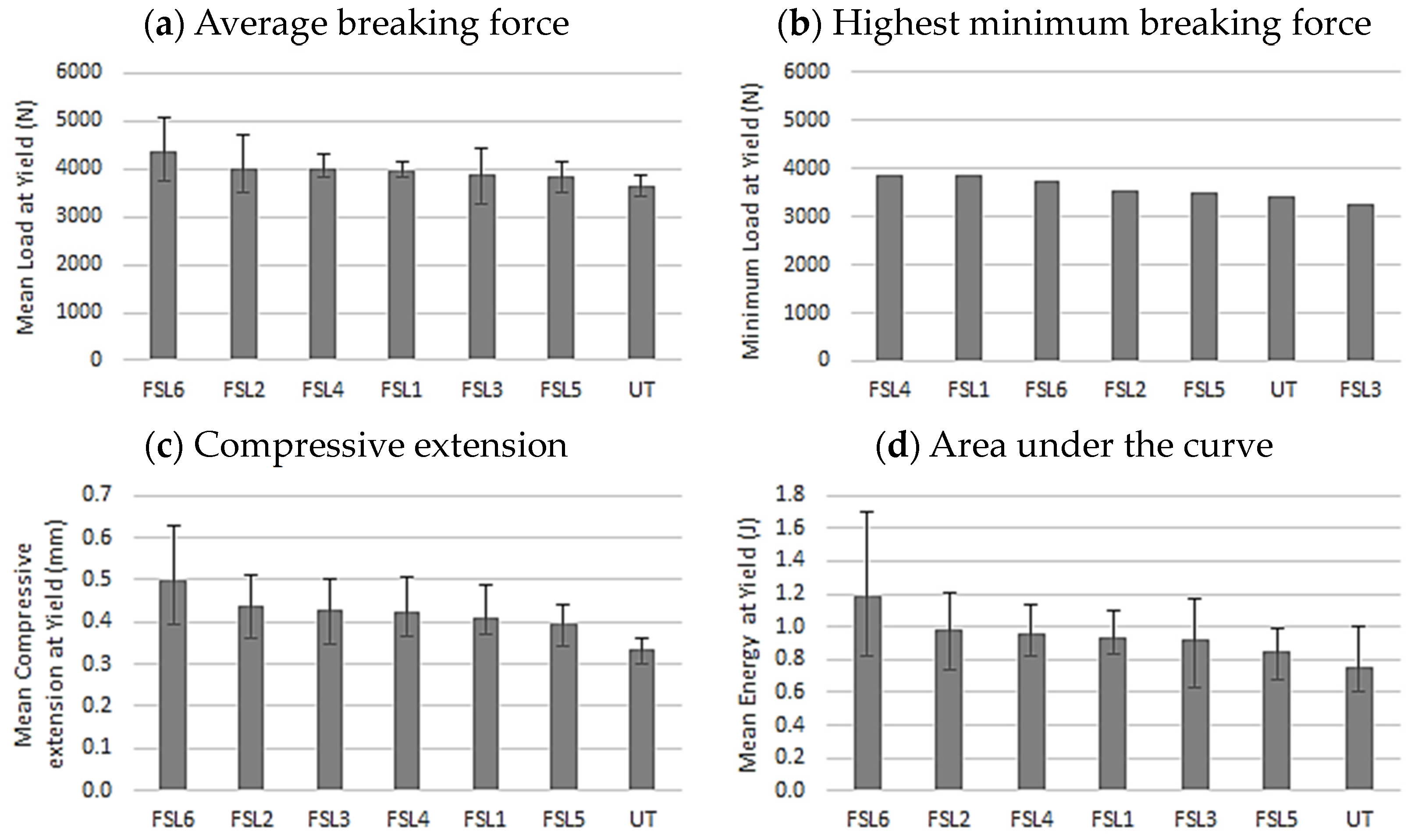
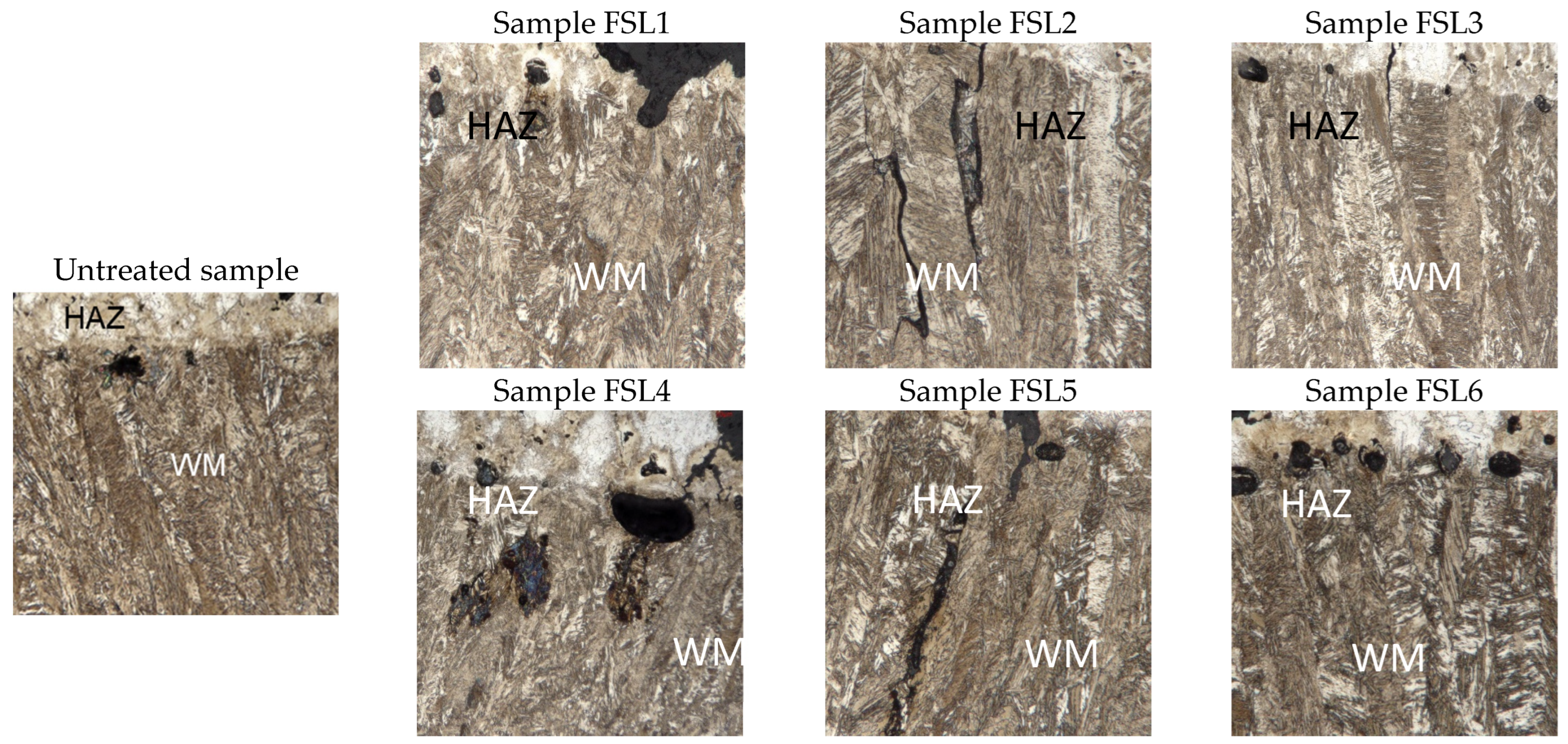


| Materials | C | Si | Mn | P | S | Astaloy-Mo | Graphite Powder | Zn-Stearate |
|---|---|---|---|---|---|---|---|---|
| Tube | ≤0.17 | ≤0.35 | ≤1.2 | ≤0.025 | ≤0.025 | - | - | - |
| Segment | - | - | - | - | - | 99.8 | 0.2 | 0.5 |
| Elements | C | O | Fe | Na | Al | Si | S | Total |
|---|---|---|---|---|---|---|---|---|
| At % 1 | 29.39 | 12.14 | 55.22 | 1.69 | 0.20 | 0.54 | 0.81 | 100 |
| wt % 2 | 56.64 | 17.15 | 22.88 | 1.71 | 0.17 | 0.45 | 0.59 | 100 |
| Laser Power (kJ/s) | Welding Speed (mm/s) | Shielding Gas | Gas Flow Rate (L/min) | Focal Length (mm) | Defocus (mm) | Heat Input (kJ/mm) |
|---|---|---|---|---|---|---|
| 2.8 | 50 | Ar | 10 | 20 | +0.25 | 0.056 |
| Samples Code | Cleaning Method | Repetition Rate | Scanning Speed (m/s) | Pulse Width (fs) | Laser Power (W) | Shielding Gas | Gas Flow Rate (L/min) | Defocus (mm) |
|---|---|---|---|---|---|---|---|---|
| FSL1 | fs | 188 kHz | 5 | 277 | 60 | Ar | 10 | 0 |
| FSL2 | fs | 188 kHz | 2.5 | 277 | 60 | Ar | 10 | 0 |
| FSL3 | fs | 750 kHz | 5 | 277 | 60 | Ar | 10 | 0 |
| FSL4 | fs | 750 kHz | 2.5 | 277 | 60 | Ar | 10 | 0 |
| FSL5 | fs | 50 MHz | 5 | 277 | 60 | Ar | 10 | 0 |
| FSL6 | fs | 50 MHz | 2.5 | 277 | 60 | Ar | 10 | 0 |
| Character | FSL1 and FSL2 | FSL3 and FSL4 | FSL5 and FSL6 |
|---|---|---|---|
| Repetition rate (Hz) | 188 × 103 | 750 × 103 | 50 × 106 |
| Peak power (W) | 1.152 × 109 | 2.888 × 108 | 4.332 × 106 |
| Energy per pulse (J) | 4 × 20 × 10−6 | 1 × 80 × 10−6 | 1 × 1.2 × 10−6 |
| Peak power density (W/mm2) | 4.024 × 108 | 1.009 × 108 | 1.513 × 108 |
| Character | UT | FSL1 | FSL2 | FSL3 | FSL4 | FSL5 | FSL6 | |
|---|---|---|---|---|---|---|---|---|
| Load (N) | SD 2 | 163 | 122 | 394 | 327 | 157 | 231 | 583 |
| Load (N) | R 3 | 444 | 317 | 1190 | 1169 | 453 | 668 | 1349 |
| C.E. (mm) 1 | SD 2 | 0.022 | 0.040 | 0.063 | 0.065 | 0.050 | 0.039 | 0.082 |
| C.E. (mm) 1 | R 3 | 0.059 | 0.119 | 0.148 | 0.155 | 0.141 | 0.098 | 0.233 |
| Energy (J) | SD 2 | 0.14 | 0.09 | 0.19 | 0.18 | 0.12 | 0.10 | 0.35 |
| Energy (J) | R 3 | 0.40 | 0.26 | 0.48 | 0.54 | 0.31 | 0.31 | 0.89 |
| Character | UT | FSL1 | FSL2 | FSL3 | FSL4 | FSL5 | FSL6 |
|---|---|---|---|---|---|---|---|
| Average number of pores | 7.75 | 6.50 | 10.25 | 7.50 | 10.50 | 7.00 | 9.50 |
| Average area of pores (mm2) | 9.987 × 10−3 | 3.389 × 10−3 | 8.736 × 10−3 | 8.386 × 10−3 | 10.016 × 10−3 | 10.084 × 10−3 | 10.906 × 10−3 |
| Average of the part broken out of the seam (%) * | 36 | 0 | 6 | 14 | 14 | 8 | 19 |
Disclaimer/Publisher’s Note: The statements, opinions and data contained in all publications are solely those of the individual author(s) and contributor(s) and not of MDPI and/or the editor(s). MDPI and/or the editor(s) disclaim responsibility for any injury to people or property resulting from any ideas, methods, instructions or products referred to in the content. |
© 2023 by the authors. Licensee MDPI, Basel, Switzerland. This article is an open access article distributed under the terms and conditions of the Creative Commons Attribution (CC BY) license (https://creativecommons.org/licenses/by/4.0/).
Share and Cite
Kenéz, A.Z.; Lublóy, É.; Bagyinszki, G.; Földes, T. Femtosecond Laser Surface Cleaning for Diamond Segmented Drill Bit Manufacturing. Crystals 2023, 13, 672. https://doi.org/10.3390/cryst13040672
Kenéz AZ, Lublóy É, Bagyinszki G, Földes T. Femtosecond Laser Surface Cleaning for Diamond Segmented Drill Bit Manufacturing. Crystals. 2023; 13(4):672. https://doi.org/10.3390/cryst13040672
Chicago/Turabian StyleKenéz, Attila Zsolt, Éva Lublóy, Gyula Bagyinszki, and Tamás Földes. 2023. "Femtosecond Laser Surface Cleaning for Diamond Segmented Drill Bit Manufacturing" Crystals 13, no. 4: 672. https://doi.org/10.3390/cryst13040672




